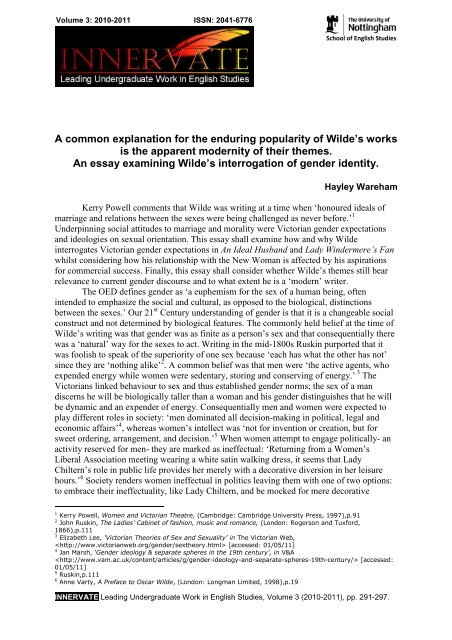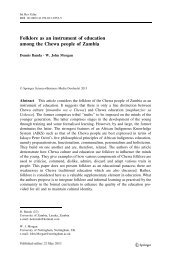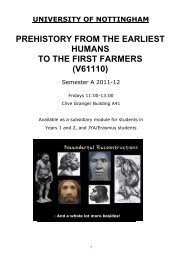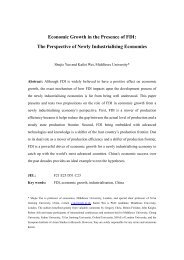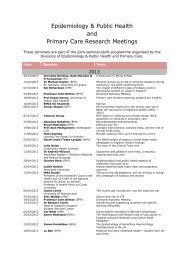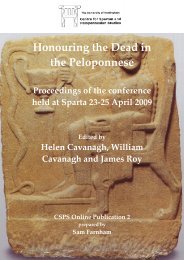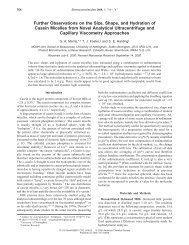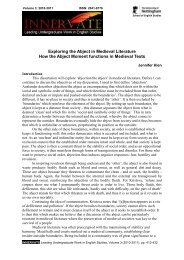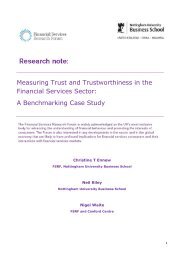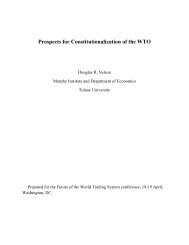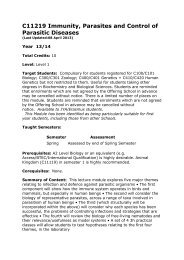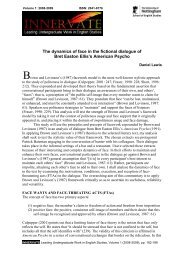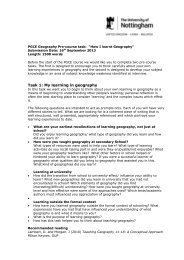A common explanation for the enduring popularity of Wilde's works ...
A common explanation for the enduring popularity of Wilde's works ...
A common explanation for the enduring popularity of Wilde's works ...
Create successful ePaper yourself
Turn your PDF publications into a flip-book with our unique Google optimized e-Paper software.
Volume 3: 2010-2011 ISSN: 2041-6776<br />
School <strong>of</strong> English Studies<br />
A <strong>common</strong> <strong>explanation</strong> <strong>for</strong> <strong>the</strong> <strong>enduring</strong> <strong>popularity</strong> <strong>of</strong> Wilde’s <strong>works</strong><br />
is <strong>the</strong> apparent modernity <strong>of</strong> <strong>the</strong>ir <strong>the</strong>mes.<br />
An essay examining Wilde’s interrogation <strong>of</strong> gender identity.<br />
Hayley Wareham<br />
Kerry Powell comments that Wilde was writing at a time when ‘honoured ideals <strong>of</strong><br />
marriage and relations between <strong>the</strong> sexes were being challenged as never be<strong>for</strong>e.’ 1<br />
Underpinning social attitudes to marriage and morality were Victorian gender expectations<br />
and ideologies on sexual orientation. This essay shall examine how and why Wilde<br />
interrogates Victorian gender expectations in An Ideal Husband and Lady Windermere’s Fan<br />
whilst considering how his relationship with <strong>the</strong> New Woman is affected by his aspirations<br />
<strong>for</strong> commercial success. Finally, this essay shall consider whe<strong>the</strong>r Wilde’s <strong>the</strong>mes still bear<br />
relevance to current gender discourse and to what extent he is a ‘modern’ writer.<br />
The OED defines gender as ‘a euphemism <strong>for</strong> <strong>the</strong> sex <strong>of</strong> a human being, <strong>of</strong>ten<br />
intended to emphasize <strong>the</strong> social and cultural, as opposed to <strong>the</strong> biological, distinctions<br />
between <strong>the</strong> sexes.’ Our 21 st Century understanding <strong>of</strong> gender is that it is a changeable social<br />
construct and not determined by biological features. The <strong>common</strong>ly held belief at <strong>the</strong> time <strong>of</strong><br />
Wilde’s writing was that gender was as finite as a person’s sex and that consequentially <strong>the</strong>re<br />
was a ‘natural’ way <strong>for</strong> <strong>the</strong> sexes to act. Writing in <strong>the</strong> mid-1800s Ruskin purported that it<br />
was foolish to speak <strong>of</strong> <strong>the</strong> superiority <strong>of</strong> one sex because ‘each has what <strong>the</strong> o<strong>the</strong>r has not’<br />
since <strong>the</strong>y are ‘nothing alike’ 2 . A <strong>common</strong> belief was that men were ‘<strong>the</strong> active agents, who<br />
expended energy while women were sedentary, storing and conserving <strong>of</strong> energy.’ 3 The<br />
Victorians linked behaviour to sex and thus established gender norms; <strong>the</strong> sex <strong>of</strong> a man<br />
discerns he will be biologically taller than a woman and his gender distinguishes that he will<br />
be dynamic and an expender <strong>of</strong> energy. Consequentially men and women were expected to<br />
play different roles in society: ‘men dominated all decision-making in political, legal and<br />
economic affairs’ 4 , whereas women’s intellect was ‘not <strong>for</strong> invention or creation, but <strong>for</strong><br />
sweet ordering, arrangement, and decision.’ 5 When women attempt to engage politically- an<br />
activity reserved <strong>for</strong> men- <strong>the</strong>y are marked as ineffectual: ‘Returning from a Women’s<br />
Liberal Association meeting wearing a white satin walking dress, it seems that Lady<br />
Chiltern’s role in public life provides her merely with a decorative diversion in her leisure<br />
hours.’ 6 Society renders women ineffectual in politics leaving <strong>the</strong>m with one <strong>of</strong> two options:<br />
to embrace <strong>the</strong>ir ineffectuality, like Lady Chiltern, and be mocked <strong>for</strong> mere decorative<br />
1 Kerry Powell, Women and Victorian Theatre, (Cambridge: Cambridge University Press, 1997),p.91<br />
2 John Ruskin, The Ladies’ Cabinet <strong>of</strong> fashion, music and romance, (London: Rogerson and Tux<strong>for</strong>d,<br />
1866),p.111<br />
3 Elizabeth Lee, ‘Victorian Theories <strong>of</strong> Sex and Sexuality’ in The Victorian Web,<br />
[accessed: 01/05/11]<br />
4 Jan Marsh, ‘Gender ideology & separate spheres in <strong>the</strong> 19th century’, in V&A<br />
[accessed:<br />
01/05/11]<br />
5 Ruskin,p.111<br />
6 Anne Varty, A Preface to Oscar Wilde, (London: Longman Limited, 1998),p.19<br />
INNERVATE Leading Undergraduate Work in English Studies, Volume 3 (2010-2011), pp. 291-297.
292 A <strong>common</strong> <strong>explanation</strong> <strong>for</strong> <strong>the</strong> <strong>enduring</strong> <strong>popularity</strong> <strong>of</strong> Wilde’s <strong>works</strong><br />
is <strong>the</strong> apparent modernity <strong>of</strong> <strong>the</strong>ir <strong>the</strong>mes.<br />
An essay examining Wilde’s interrogation <strong>of</strong> gender identity.<br />
participation. Or, to assert political authority through illegal exploitations like Mrs Cheverly,<br />
‘This is <strong>the</strong> game <strong>of</strong> life as we all have to play it, Sir Robert, sooner or later!’ 7 David<br />
Cameron recently told a female MP to ‘Calm down dear’, highlighting <strong>the</strong> contemporary<br />
relevance <strong>of</strong> Wilde’s social comedies. Elliot comments that ‘"Calm down, dear" is what<br />
women hear when we're allegedly being "hysterical" or "overemotional". It's that tired old<br />
gender stereotyping, <strong>the</strong> sort that implies that if we can't even keep our emotions in check,<br />
<strong>the</strong>n we obviously aren't cut out <strong>for</strong> <strong>the</strong> more serious male world <strong>of</strong> politics and debate.’ 8<br />
Cameron- whe<strong>the</strong>r inadvertently or not- employed <strong>the</strong> Victorian idea <strong>of</strong> <strong>the</strong> politically<br />
ineffectual woman who, because <strong>of</strong> her natural gender make-up, is unable to contribute to <strong>the</strong><br />
political, public side <strong>of</strong> society.<br />
The ‘natural’ disposition <strong>of</strong> women as weaker than men manifests in social<br />
expectations <strong>of</strong> gender. Carpenter declared in 1880 that ‘A lady should not attend a public<br />
ball without an escort… in fact, no lady should be left unattended’ 9 . Out <strong>of</strong> this social climate<br />
grew demands <strong>for</strong> expanded liberties <strong>for</strong> women, ‘e.g. <strong>the</strong> rights <strong>of</strong> voting, property and<br />
access to higher education’ 10 , and by <strong>the</strong> late 19 th Century <strong>the</strong>se demands had given birth to<br />
<strong>the</strong> New Woman. The New Woman ‘seemed to dissolve <strong>the</strong> boundaries <strong>of</strong> traditional gender<br />
roles… The New Woman was self-confident and enlightened, and was violating Victorian<br />
conventions <strong>of</strong> femininity’. 11<br />
As editor <strong>of</strong> Woman’s World in <strong>the</strong> late 1880s, Wilde was consciously engaged in <strong>the</strong><br />
evolution <strong>of</strong> <strong>the</strong> New Woman. Sloan comments that ‘Wilde encouraged his contributors to<br />
disregard conventional ideals <strong>of</strong> femininity and gender’ and ‘provided a plat<strong>for</strong>m <strong>for</strong> women<br />
to construct a new image <strong>of</strong> <strong>the</strong>mselves <strong>for</strong> <strong>the</strong>mselves.’ 12 Wilde’s relationship with <strong>the</strong> New<br />
Woman also manifests in his society comedies. Sloan comments that Mabel Chiltern is ‘an<br />
irreverent New Woman posing as ingénue.’ 13 Mabel clearly knows her own mind and desires<br />
to express her identity through her attire: ‘Gertrude won’t let me wear anything but pearls,<br />
and I am thoroughly sick <strong>of</strong> pearls. They make one look so plain, so good and intellectual.’<br />
(531) Gertrude, perhaps believing that pearls connote purity and femininity, insists that<br />
Mabel wears <strong>the</strong>m in order that she con<strong>for</strong>ms to gender expectations and is in no danger <strong>of</strong><br />
being perceived as a New Woman. Wilde suggests that it was not only men who attempted to<br />
preserve gender norms.<br />
Mrs Erylnne in Lady Windermere’s Fan is arguably a more identifiable New Woman.<br />
She occupies male environments with ease- advising and consoling Lady Windermere in <strong>the</strong><br />
exclusively male setting <strong>of</strong> Lord Darlington’s room- and her discourse ‘matched that <strong>of</strong> <strong>the</strong><br />
men’ 14 ; she demonstrates she can engage in male conversations through her political<br />
awareness: ‘He thinks like a Tory, and talks like a Radical, and that’s so important<br />
nowadays.’ (436) The Victorian press channelled <strong>the</strong> idea that <strong>the</strong> New Woman was a<br />
‘mannish, over-educated, humourless bores.’ 15 Mrs Erylnne is described as ‘beautifully<br />
dressed and very dignified’ (436) so although engaged in male discourse, does not con<strong>for</strong>m to<br />
7 Oscar Wilde, The Complete Works <strong>of</strong> Oscar Wilde, ed. by Merlin Holland, 5 th edn (London: HarperCollins<br />
Publishers, 2003),p.528. Fur<strong>the</strong>r references to this edition given directly after <strong>the</strong> quotation.<br />
8 Cath Elliott, ‘Cameron's 'Calm down, dear' is a classic sexist put-down’, Guardian, (27/04/11)<br />
<br />
[accessed: 29/04/11]<br />
9 Lucien O. Carpenter, Universal Dancing Master. (London: 1880) Source:<br />
[accessed: 30/04/11]<br />
10 Jessica Menz, Dandies and <strong>the</strong>ir misogynistic attitudes in Oscar Wilde’s The Picture <strong>of</strong> Dorian Gray,<br />
(Germany: Grin, 2004),p.5<br />
11 Ibid.<br />
12 John Sloan, Authors in Context: Oscar Wilde (Ox<strong>for</strong>d: Ox<strong>for</strong>d University Press, 2003),p.105<br />
13 Sloan,p.114<br />
14 Varty,p.161<br />
15 Sally Ledger, The New Woman: fiction and feminism at <strong>the</strong> fin de siècle, (Manchester: Manchester University<br />
Press, 1997),p.96<br />
INNERVATE Leading Undergraduate Work in English Studies, Volume 3 (2010-2011), pp. 291-297.
Hayley Wareham 293<br />
<strong>the</strong> Victorian projected aes<strong>the</strong>tic <strong>of</strong> <strong>the</strong> New Woman. In subverting this image, Wilde has<br />
attempted to challenge his audience’s expectations <strong>of</strong> gender by suggesting that a woman can<br />
be both intelligent and attractive. However, <strong>the</strong>se combined characteristics come at a high<br />
price <strong>for</strong> Mrs Erylnne who has to hide her past and ‘live selfishly as <strong>the</strong> dictates <strong>of</strong> a selfish<br />
society.’ 16 Conscious <strong>of</strong> <strong>the</strong> Victorian’s fear <strong>of</strong> too powerful a New Woman, Wilde ends his<br />
play with Mrs Erylnne engaged to Lord Augustus; although she does not fulfil her role as<br />
mo<strong>the</strong>r, she does fulfil <strong>the</strong> role <strong>of</strong> wife so that she is at least in part con<strong>for</strong>ming to gender<br />
norms.<br />
Speaking on <strong>the</strong> New Woman, Varty comments that ‘<strong>the</strong>re was a very real fear that<br />
she may not be at all interested in men, and could manage quite well without <strong>the</strong>m.’ 17<br />
Desiring commercial success <strong>for</strong> Lady Windermere’s Fan, Wilde was careful not to inflame<br />
too greatly, Victorian fears about <strong>the</strong> New Woman. This was arguably a wise move<br />
commercially because <strong>the</strong> fear <strong>of</strong> women not needing men is still at <strong>the</strong> <strong>for</strong>efront <strong>of</strong> feminist<br />
discussions in <strong>the</strong> 21 st century. Writing <strong>for</strong> The Telegraph, Odone comments that feminists<br />
‘have undermined working class men with <strong>the</strong>ir philosophy that all males are<br />
expendable. Women don’t need men: not as husbands’. 18 Echoing Victorian gender ideals,<br />
Odone holds women accountable <strong>for</strong> <strong>the</strong> plight <strong>of</strong> <strong>the</strong> working class man because women are<br />
no longer con<strong>for</strong>ming to <strong>the</strong> gender mould <strong>of</strong> mo<strong>the</strong>r and wife and so exist without <strong>the</strong>ir male<br />
counter-part; women are no longer defined by <strong>the</strong>ir relationship to men, i.e. wife or mo<strong>the</strong>r.<br />
Writing in <strong>the</strong> 1860s, Linton slams what she calls this ‘wild revolt against nature, and<br />
specifically this abhorrence <strong>of</strong> maternity’. 19 Mrs. Erylnne does not express maternal feelings<br />
towards Lady Windermere until twenty-one years after giving birth to her: ‘I feel a passion<br />
awakening within me that I never felt be<strong>for</strong>e.’ (444). Victorian thinking attributed moral<br />
decline to lack <strong>of</strong> maternity, ‘those times in a nation’s history when women have been social<br />
ornaments ra<strong>the</strong>r than family homestays have ever been times <strong>of</strong> national decadence and<br />
moral failure.’ 20 The residing ideology appears to be that women are accountable <strong>for</strong> social<br />
decay when <strong>the</strong>y fail to con<strong>for</strong>m to <strong>the</strong> gender role presented to <strong>the</strong>m by society.<br />
A Victorian audience would have been familiar with a character like Mrs Erylnne,<br />
Powell comments: ‘By <strong>the</strong> year 1892… <strong>the</strong> absconded mo<strong>the</strong>r was a stock character who<br />
could be relied upon <strong>for</strong> a tearful curtain and nostalgic invocation <strong>of</strong> settled values’. 21<br />
However, <strong>the</strong> audience are not allowed a tearful reconciliation between mo<strong>the</strong>r and daughter<br />
since Wilde attempts to expose <strong>the</strong> paradoxical hypocrisy <strong>of</strong> Victorian society. Mrs Erylnne<br />
is punished <strong>for</strong> not con<strong>for</strong>ming to <strong>the</strong> gender norm <strong>of</strong> mo<strong>the</strong>r but is rendered unable to<br />
con<strong>for</strong>m to this role because <strong>of</strong> <strong>the</strong> social repercussions; her daughter’s pure and good<br />
reputation would be tarnished. Lady Windermere’s Puritanism prevents her from learning <strong>the</strong><br />
identity <strong>of</strong> her mo<strong>the</strong>r because she does not develop her ‘simple concept <strong>of</strong> good and bad’ 22<br />
and at <strong>the</strong> end <strong>of</strong> <strong>the</strong> play ‘she has learned nothing’ 23 . Lady Windermere does not deserve to<br />
learn <strong>the</strong> truth because she ranks ideals above reality, saying ‘We all have ideals in life…<br />
Mine is my mo<strong>the</strong>r’ (461). Lady Windermere acts as a microcosm <strong>for</strong> Victorian morality; her<br />
resolute belief in <strong>the</strong> ideal hinders her development. ‘Nietzsche revealed value as a fraud, a<br />
16 Varty,p.161<br />
17 Ledger,p.5<br />
18 Cristina Odone, ‘Why David Willetts is wrong about feminism’, Telegraph, (01/04/11)<br />
<br />
[accessed: 17/04/11]<br />
19 Elizabeth Lynn Linton, Modern Women and What is Said <strong>of</strong> Them, (New York: J.S.Redfield Publisher,<br />
1868),p.301<br />
20 ibid<br />
21 Kerry Powell, Oscar Wilde and <strong>the</strong> <strong>the</strong>atre <strong>of</strong> <strong>the</strong> 1890s, (Cambridge: Cambridge University Press, 1990),<br />
p.11<br />
22 Peter Raby, ‘<strong>Wilde's</strong> comedies <strong>of</strong> Society’ in The Cambridge Companion to Oscar Wilde, ed. Peter<br />
Raby. (Cambridge: Cambridge University Press, 1997), p.84<br />
23 Morse Peckham, ‘What Did Lady Windermere Learn?’, College English, I, XV111 (1956), 11-14, (p.13)<br />
INNERVATE Leading Undergraduate Work in English Studies, Volume 3 (2010-2011), pp. 291-297.
294 A <strong>common</strong> <strong>explanation</strong> <strong>for</strong> <strong>the</strong> <strong>enduring</strong> <strong>popularity</strong> <strong>of</strong> Wilde’s <strong>works</strong><br />
is <strong>the</strong> apparent modernity <strong>of</strong> <strong>the</strong>ir <strong>the</strong>mes.<br />
An essay examining Wilde’s interrogation <strong>of</strong> gender identity.<br />
tool <strong>of</strong> domination <strong>of</strong> some over o<strong>the</strong>rs’. 24 Wilde too identifies Victorian values as fraudulent<br />
and undermines <strong>the</strong>m through Lady Windermere’s fickleness. She is elevated as this pure,<br />
good woman and yet she is willing to throw it all away in a second, ‘Tonight a man who<br />
loved me <strong>of</strong>fered me his whole life. I refused it. It was foolish <strong>of</strong> me. I will <strong>of</strong>fer him mine<br />
now.’ (442). Ellmann observes that ‘Lady Windermere is tempted by her own morality to<br />
behave in a way alien to her character’. 25 Her values are reduced to nothing; this perfect,<br />
‘ideal’ woman- a woman who used her infallibility to lecture her husband- is exposed as a<br />
flawed and fallible character. When Robert Chiltern is exposed as imperfect, <strong>the</strong> blame is<br />
attributed to Lady Chiltern because she, and o<strong>the</strong>r women, place men on ‘monstrous<br />
pedestals’ (552). Lady Chiltern <strong>for</strong>gives Robert Chiltern, realising she ‘set him too high’<br />
(579). Wilde attempts to expose <strong>the</strong> inequitable ideology that attributes all social immorality<br />
to women.<br />
McKenna compares <strong>the</strong> actions <strong>of</strong> Sir Robert to <strong>the</strong> actions <strong>of</strong> Wilde, claiming <strong>the</strong>y<br />
are both ‘far from ideal husbands’ but that An Ideal Husband ‘ends with a heart-felt plea <strong>for</strong><br />
<strong>for</strong>giveness… The unconditional, unequal love <strong>of</strong> a woman <strong>for</strong> her husband holds within<br />
itself <strong>the</strong> power <strong>of</strong> redemption.’ 26 Ra<strong>the</strong>r than presenting <strong>the</strong> selfless default setting <strong>of</strong><br />
<strong>for</strong>giveness <strong>of</strong> womankind, I would argue Wilde sets up impossible ideals <strong>for</strong> both genders in<br />
order to expose <strong>the</strong> Victorians’ ludicrous fixation with correctness and <strong>the</strong> gender norms<br />
affecting perception <strong>of</strong> behaviour. The significance gender plays in <strong>the</strong> presentation <strong>of</strong><br />
behaviour is still very much apparent in <strong>the</strong> 21 st Century and it appears <strong>the</strong>re is still an<br />
unwritten belief that women are more moral than men. When a teenager was recently<br />
attacked, <strong>the</strong> press focus was on <strong>the</strong> sex <strong>of</strong> <strong>the</strong> perpetrator: ‘It did not seem natural <strong>for</strong> such a<br />
young girl to be capable <strong>of</strong> such violence’. ‘Such a brutal attack challenged our society’s<br />
accepted wisdom about girls.’ 27 Clearly <strong>the</strong>re is still a concept <strong>of</strong> ‘natural’ gender norms,<br />
meaning we still consider that gender is dominated by nature, not nurture.<br />
Wilde and his contemporaries fought against <strong>the</strong> gender norms because <strong>the</strong>y ‘became<br />
a socially structured means <strong>of</strong> en<strong>for</strong>cing morals’ 28 . Victorian morality also dictated sexual<br />
activity: ‘According to medical <strong>the</strong>ories on sexuality <strong>of</strong> that time… sexual impulses existed<br />
only <strong>for</strong> natural reproductive reasons and any kind <strong>of</strong> excess could lead to physical or mental<br />
illness’ 29 . Thus, sexual activity that was driven by a desire <strong>for</strong> pleasure not procreation- sex<br />
between men- was unnatural and blamed <strong>for</strong> physical and mental illnesses <strong>of</strong> <strong>the</strong> time. Wilde<br />
was conscious that <strong>the</strong> fight <strong>for</strong> equality between men and women and a re-establishing <strong>of</strong><br />
gender norms was <strong>the</strong> first step towards a re-evaluation <strong>of</strong> homosexual activity. Ledger<br />
comments that <strong>the</strong> movement <strong>of</strong> <strong>the</strong> New Woman was entangled with ‘decadence… and<br />
emergent homosexual identities.’ 30 Wilde was arguably acutely aware <strong>of</strong> <strong>the</strong> relationship <strong>the</strong><br />
New Woman had with his own identity and so unsurprisingly, became involved in <strong>the</strong>ir work.<br />
Although evidence <strong>of</strong> gender interrogation and a criticism <strong>of</strong> Victorian values exist in<br />
Wilde’s society comedies, he was conscious <strong>of</strong> <strong>the</strong> danger in engaging too conspicuously<br />
with <strong>the</strong> ideas <strong>of</strong> <strong>the</strong> New Woman. Sloan comments that Wilde vigilantly featured<br />
domesticity and women’s fashions in Woman’s World because to have ignored <strong>the</strong>m ‘would<br />
24 Reginia Gagnier ‘Wilde and <strong>the</strong> Victorians’ in The Cambridge Companion to Oscar Wilde, ed. Peter<br />
Raby. (Cambridge: Cambridge University Press, 1997), pp.18- 33, (p.18)<br />
25 Richard Ellmann, Oscar Wilde, (London: Penguin Books, 1987), p.343<br />
26 Neil McKenna, The Secret Life <strong>of</strong> Oscar Wilde, (London: Arrow Books, 2004), p.329<br />
27 Mark Macaskill and Karin Goodwin, ‘Focus: Women behaving badly’ Sunday Times<br />
(02/05/04) [accessed: 03/05/11]<br />
28 Jessica Simmons, ‘Algernon Charles Swinburne and <strong>the</strong> Philosophy <strong>of</strong> Androgyny, Hermaphrodeity, and<br />
Victorian Sexual Mores’ in The Victorian Web<br />
[accessed: 16/04/11]<br />
29 Menz,p.4<br />
30 Ledger,p.4<br />
INNERVATE Leading Undergraduate Work in English Studies, Volume 3 (2010-2011), pp. 291-297.
Hayley Wareham 295<br />
have been commercial suicide.’ 31 Wilde, characteristically, was still keen to fur<strong>the</strong>r his<br />
literary career and public image and so was careful not to ignore <strong>the</strong> demands <strong>of</strong><br />
consumerism. Wilde obstructs his criticism <strong>of</strong> Victorian gender norms through paradoxes and<br />
<strong>the</strong> character <strong>of</strong> <strong>the</strong> dandy. Wilde is able to subvert ideologies through this whimsical<br />
character because <strong>of</strong> his flippant, flamboyant nature: Lord Goring is described as ‘Thirtyfour,<br />
but always says he is younger… A flawless dandy… He is fond <strong>of</strong> being misunderstood.’<br />
(521). The dandy character admits to frequent lying and so who can say what he- or Wildereally<br />
believes. Wilde both ‘criticized and attracted <strong>the</strong> upper classes’ 32 through <strong>the</strong> sardonic,<br />
intelligent, yet unthreatening character <strong>of</strong> <strong>the</strong> dandy.<br />
The trials <strong>of</strong> Oscar Wilde in 1895 ‘crystallised in <strong>the</strong> general psyche <strong>the</strong> challenge to<br />
gender definitions posed by <strong>the</strong> decadents and <strong>the</strong> New Woman’. 33 Wilde threatened <strong>the</strong><br />
Victorian status-quo through his interrogation <strong>of</strong> gender norms and his relationship with <strong>the</strong><br />
New Woman. Ledger comments that ‘The ‘newness’ <strong>of</strong> <strong>the</strong> New Woman marked her as an<br />
unmistakably ‘modern’ figure, a figure committed to change and to <strong>the</strong> values <strong>of</strong> a projected<br />
future.’ 34 Not believing art should be didactic, it is possible that Wilde instead engaged with<br />
<strong>the</strong> work <strong>of</strong> <strong>the</strong> New Woman because he was conscious <strong>of</strong> <strong>the</strong>ir modernity and aspired to give<br />
commercial longevity to his work by engaging with ideas he felt would be discussed <strong>for</strong> years<br />
to come. However <strong>the</strong> cynicism <strong>of</strong> this notion neglects Wilde’s commitment to his<br />
interrogation <strong>of</strong> established gender norms and <strong>the</strong> social climate <strong>of</strong> his writing; <strong>the</strong> threat <strong>of</strong><br />
blatant criticism <strong>of</strong> Victorian morality was dangerous not only artistically <strong>for</strong> Wilde- <strong>the</strong> Lord<br />
Chamberlain had <strong>the</strong> power to prevent any play deemed illicit from being per<strong>for</strong>med- but also<br />
personally. Ultimately, whe<strong>the</strong>r <strong>for</strong> artistic or commercial reasons, Wilde’s interrogations <strong>of</strong><br />
gender norms- <strong>the</strong> ineffectuality <strong>of</strong> women in politics and <strong>the</strong> ‘natural’ role <strong>of</strong> mo<strong>the</strong>r/wifestill<br />
bear contemporary relevance. His society comedies have undoubtedly endured, in part,<br />
because <strong>of</strong> <strong>the</strong> modernity <strong>of</strong> <strong>the</strong>ir examination <strong>of</strong> gender.<br />
31 Sloan,p.105<br />
32 Regenia Gagnier, Idylls <strong>of</strong> <strong>the</strong> Market Place: Oscar Wilde and <strong>the</strong> Victorian Public, (Aldershot: Gower<br />
Publishing Company Limited, 1987),p.117<br />
33 Ledger,p.95<br />
34 Ibid., p.5<br />
INNERVATE Leading Undergraduate Work in English Studies, Volume 3 (2010-2011), pp. 291-297.
296 A <strong>common</strong> <strong>explanation</strong> <strong>for</strong> <strong>the</strong> <strong>enduring</strong> <strong>popularity</strong> <strong>of</strong> Wilde’s <strong>works</strong><br />
is <strong>the</strong> apparent modernity <strong>of</strong> <strong>the</strong>ir <strong>the</strong>mes.<br />
An essay examining Wilde’s interrogation <strong>of</strong> gender identity.<br />
Bibliography<br />
Primary Text:<br />
Wilde, Oscar, The Complete Works <strong>of</strong> Oscar Wilde, ed. by Merlin Holland, 5 th edn (London:<br />
HarperCollins Publishers, 2003)<br />
Secondary Texts:<br />
Carpenter, Lucien O., Universal Dancing Master. (London: 1880) Source:<br />
[accessed: 30/04/11]<br />
Elliott, Cath, ‘Cameron's 'Calm down, dear' is a classic sexist put-down’, Guardian,<br />
(27/04/11) <br />
[accessed: 29/04/11]<br />
Ellmann, Richard, Oscar Wilde, (London: Penguin Books, 1987)<br />
Gagnier, Regenia, Idylls <strong>of</strong> <strong>the</strong> Market Place: Oscar Wilde and <strong>the</strong> Victorian Public,<br />
(Aldershot: Gower Publishing Company Limited, 1987)<br />
Gagnier, Reginia, ‘Wilde and <strong>the</strong> Victorians’ in The Cambridge Companion to Oscar<br />
Wilde, ed. Peter Raby. (Cambridge: Cambridge University Press, 1997)<br />
Kaplin, Joel, ‘Wilde on <strong>the</strong> stage’ in The Cambridge Companion to Oscar Wilde, ed. Peter<br />
Raby. (Cambridge: Cambridge University Press, 1997)<br />
Ledger, Sally, The New Woman: fiction and feminism at <strong>the</strong> fin de siècle, (Manchester:<br />
Manchester University Press, 1997)<br />
Lee, Elizabeth, ‘Victorian Theories <strong>of</strong> Sex and Sexuality’ in The Victorian Web,<br />
[accessed: 01/05/11]<br />
Linton, Elizabeth Lynn, Modern Women and What is Said <strong>of</strong> Them, (New York: J.S.Redfield<br />
Publisher, 1868)<br />
Macaskill, Mark and Goodwin, Karin, ‘Focus: Women behaving badly’ Sunday Times<br />
(02/05/04) [accessed: 03/05/11]<br />
Marsh, Jan, ‘Gender ideology & separate spheres in <strong>the</strong> 19th century’, in V&A<br />
<br />
[accessed: 01/05/11]<br />
McGhee, Richard D., Marriage, Duty and Desire in Victorian Poetry and Drama, (USA: The<br />
Regents Press <strong>of</strong> Kansas, 1980)<br />
McKenna, Neil, The Secret Life <strong>of</strong> Oscar Wilde, (London: Arrow Books, 2004)<br />
INNERVATE Leading Undergraduate Work in English Studies, Volume 3 (2010-2011), pp. 291-297.
Hayley Wareham 297<br />
Menz, Jessica, Dandies and <strong>the</strong>ir misogynistic attitudes in Oscar Wilde’s The Picture <strong>of</strong><br />
Dorian Gray, (Germany: Grin, 2004)<br />
Mulholland, Hélène. ‘David Willetts blames feminism over lack <strong>of</strong> jobs <strong>for</strong> working men’,<br />
Guardian, (01/04/11), <br />
[accessed: 15/04/11]<br />
Odone, Cristina ‘Why David Willetts is wrong about feminism’, Telegraph, (01/04/11)<br />
<br />
[accessed: 17/04/11]<br />
Peckham, Morse, ‘What Did Lady Windermere Learn?’, College English, I, XV111 (1956),<br />
11-14<br />
Powell, Kerry, Oscar Wilde and <strong>the</strong> <strong>the</strong>atre <strong>of</strong> <strong>the</strong> 1890s, (Cambridge: Cambridge University<br />
Press, 1990)<br />
Powell, Kerry, Women and Victorian Theatre, (Cambridge: Cambridge University Press,<br />
1997)<br />
Ruskin, John, The Ladies’ Cabinet <strong>of</strong> fashion, music and romance, (London: Rogerson and<br />
Tux<strong>for</strong>d, 1866)<br />
Raby, Peter, ‘<strong>Wilde's</strong> comedies <strong>of</strong> Society’ in The Cambridge Companion to Oscar<br />
Wilde, ed. Peter Raby. (Cambridge: Cambridge University Press, 1997)<br />
Self, Helen J., Prostitution, women and misuse <strong>of</strong> <strong>the</strong> law: <strong>the</strong> fallen daughters <strong>of</strong> Eve,<br />
(London: Frank Cass Publishers, 2003)<br />
Simmons, Jessica, ‘Algernon Charles Swinburne and <strong>the</strong> Philosophy <strong>of</strong> Androgyny,<br />
Hermaphrodeity, and Victorian Sexual Mores’ in The Victorian Web<br />
[accessed: 16/04/11]<br />
Sloan, John, Authors in Context: Oscar Wilde (Ox<strong>for</strong>d: Ox<strong>for</strong>d University Press, 2003)<br />
Varty, Anne, A Preface to Oscar Wilde, (London: Longman Limited, 1998)<br />
INNERVATE Leading Undergraduate Work in English Studies, Volume 3 (2010-2011), pp. 291-297.


